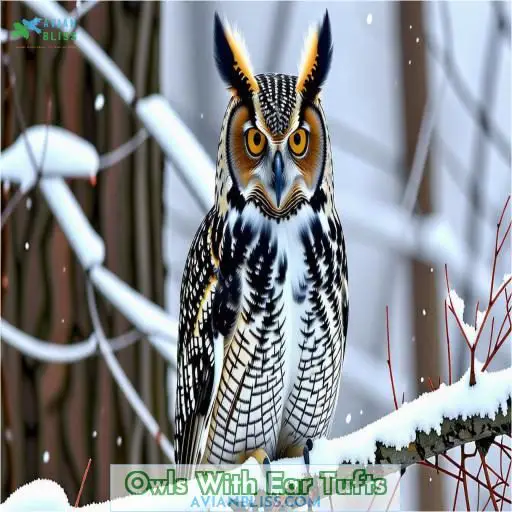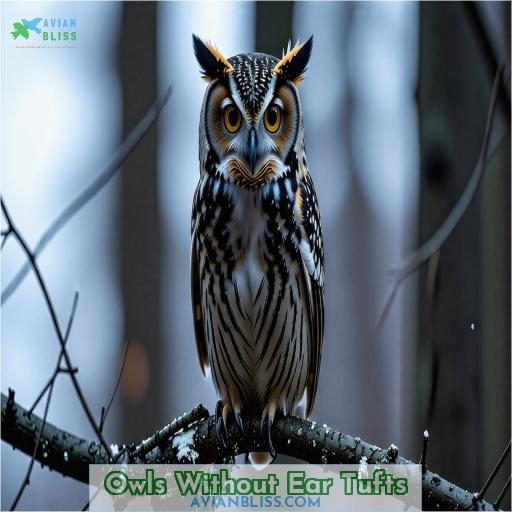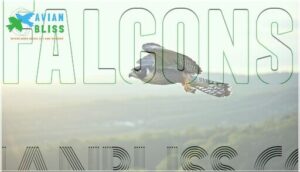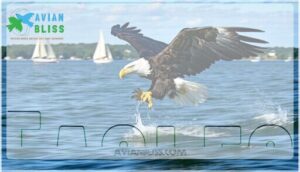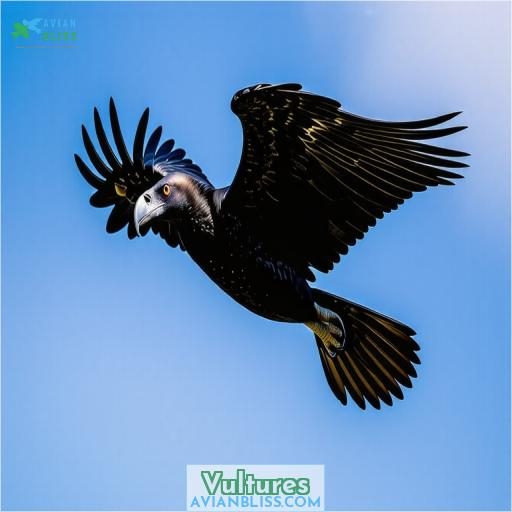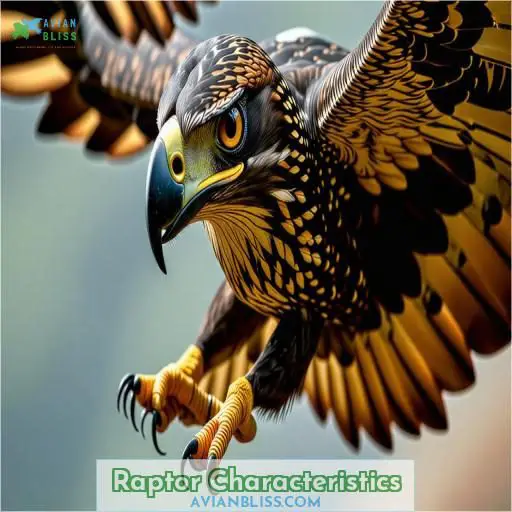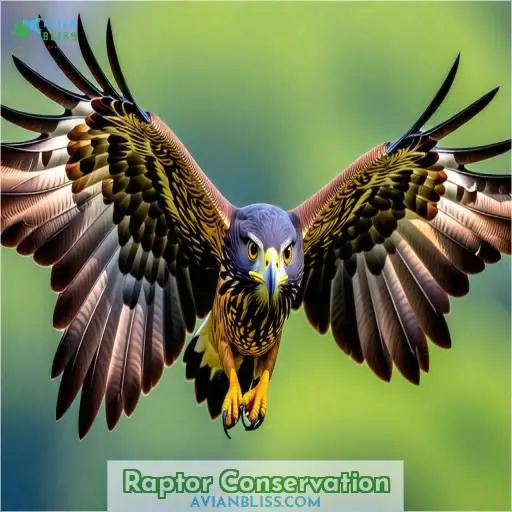This site is supported by our readers. We may earn a commission, at no cost to you, if you purchase through links.
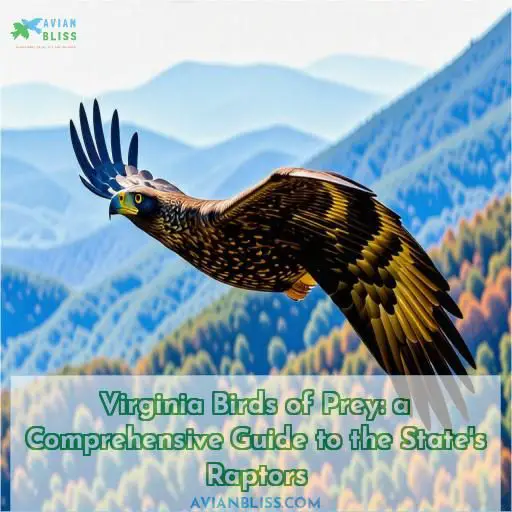
Our state hosts a diverse array of birds of prey, from majestic eagles to stealthy owls.
Get ready to spot the iconic bald eagle soaring over waterways or the elusive barred owl hidden in dense forests.
Marvel at the impressive hunting skills of hawks like the red-tailed and Cooper’s, or keep an eye out for the acrobatic merlin falcon diving after its prey.
With habitats ranging from coastal marshes to mountain ridges, Virginia offers ample opportunities to observe these remarkable raptors in action.
But don’t stop here – there’s much more to uncover about these fascinating birds.
Table Of Contents
- Key Takeaways
- Owls With Ear Tufts
- Owls Without Ear Tufts
- Hawks
- Falcons
- Eagles
- Vultures
- Raptor Characteristics
- Raptor Conservation
- Frequently Asked Questions (FAQs)
- What are the small raptors in Virginia?
- How do you identify a hawk in Virginia?
- What kind of eagles are in Virginia?
- Are there any falcons in Virginia?
- How do raptors eyes differ from humans?
- Why do some owls have ear tufts while others dont?
- Which raptor species are most threatened by wind turbines?
- How do raptors hunting strategies vary by species?
- What is the purpose of the facial discs on owls?
- Conclusion
Key Takeaways
- You’re in for an absolute treat as a nature enthusiast in Virginia, my friend! Get ready to witness the grace and power of majestic eagles soaring overhead, the stealthy prowess of owls silently hunting in the night, and the incredible aerial acrobatics of falcons diving at breakneck speeds after their prey.
- While these remarkable birds of prey once faced dire threats from pesticides like DDT and habitat loss, conservation efforts have brought iconic species like the bald eagle and peregrine falcon back from the brink of extinction. It’s a testament to humanity’s ability to right our wrongs and ensure these magnificent creatures continue to grace our skies.
- Each raptor species has its own unique adaptations and hunting strategies that are simply awe-inspiring. From the powerful talons and razor-sharp beaks perfect for tearing flesh, to the exceptional eyesight that allows them to spot prey from miles away, these birds are true masters of their domain.
- Whether you’re marveling at the massive nests of bald eagles, listening for the haunting calls of a barred owl in the night, or watching a red-tailed hawk soar effortlessly on thermals, Virginia’s diverse landscapes offer countless opportunities to experience the majesty of these incredible birds of prey. It’s an adventure waiting to unfold!
Owls With Ear Tufts
You’re in for a treat when spotting owls with ear tufts in Virginia. The great horned owl, short-eared owl, Eastern screech owl, long-eared owl, and barred owl all sport this distinctive feature, resembling horns or ears atop their heads.
Great Horned Owl
The Great Horned Owl, a nocturnal raptor in Virginia, boasts:
- Silent flight with soft feathers
- Facial discs and off-center ears for dim light vision
- Powerful talons and hooked beak for hunting prey
Short-eared Owl
The Short-eared Owl’s distinctive flight and ear tufts set it apart. These nocturnal raptors thrive in open habitats, hunting small mammals at dawn and dusk. Their adaptations make them masters of the night skies .
Eastern Screech Owl
The Eastern Screech Owl, a common Virginia resident, thrives in diverse habitats, feasting on rodents and insects. Its haunting trills and whinnies pierce the night, a demonstration of this owl’s adaptability and resilience in the Commonwealth’s avian tapestry.
Long-eared Owl
The long-eared owl, a nocturnal raptor, prefers dense woodlands and hunts small rodents. Its ear tufts, though prominent, are closer together than the great horned owl’s. Populations are stable, but habitat loss remains a concern .
Barred Owl
The Barred Owl, a nocturnal hunter in Virginia, has a facial disc and off-center ear openings aiding in sound capture. Alongside the Northern Saw-whet Owl, Barn Owl, hawks, and vultures, it exemplifies the diverse raptor species in the region.
Owls Without Ear Tufts
Barn Owls and Saw-whet Owls are two species of Virginia raptors that lack ear tufts, the feathery projections found on many other owl species. These owls rely on their exceptional hearing and silent flight to hunt small mammals, birds, and insects in open fields, forests, and suburban areas.
Barn Owl
The barn owl is a distinctive raptor known for its ghostly white face and lack of ear tufts.
These silent hunters use their exceptional hearing to locate small rodents in open fields and grasslands. Their heart-shaped facial discs funnel sound to their asymmetrical ears, allowing them to pinpoint prey even in complete darkness.
Barn owls are found throughout Virginia, often nesting in abandoned buildings, barns, and tree cavities. Their diet consists mainly of voles, mice, and shrews.
Unlike other owls, barn owls aren’t territorial and may roost communally. Their haunting screeches are a common sound on quiet nights.
While not as well-known as the red-tailed hawk or peregrine falcon, barn owls play an integral role in controlling rodent populations.
Saw-whet Owl
The Northern Saw-whet Owl, a nocturnal predator, exhibits a diverse diet including small mammals and birds . With a preference for dense coniferous forests especially during nesting, these secretive, small owls face conservation concerns due to habitat loss and deforestation within their breeding range . This elusive species has particularly benefitted from conservation efforts following the banning of DDT, akin to the Bald Eagle, Osprey, and Mississippi Kite. In contrast, the Coopers Hawk and Red-tailed Hawks, along with many other raptors, declined markedly due to DDT use, highlighting the importance of ongoing conservation initiatives .
- Feel the sense of freedom as the Northern Saw-whet Owl gracefully glides through the dark forest in search of prey.
- Experience the thrill of observing the diverse diet of the Northern Saw-whet Owl, a proof of its remarkable hunting abilities.
- Understand the urgency of conservation efforts in preserving the habitat and future of the Northern Saw-whet Owl, alongside other at-risk raptor species .
Hawks
You’ll find six species of hawks nesting in Virginia. These include the buteo hawks like the red-tailed, red-shouldered, and broad-winged hawks, which soar in high circles with their long, broad wings and rounded tails; as well as the accipiter hawks such as Cooper’s and sharp-shinned hawks, which have short, wide, rounded wings and long, narrow tails ideal for capturing songbirds.
Red-shouldered Hawk
The red-shouldered hawk, a buteo, thrives in moist woodlands, hunting small mammals, reptiles, and amphibians. Its numbers declined due to habitat loss but have rebounded through conservation efforts .
Red-tailed Hawk
The Red-tailed Hawk demonstrates diverse migration patterns, faces habitat destruction threats affecting prey availability, exhibits notable population trends, leading to essential conservation measures under the Endangered Species Act to combat challenges like lead poisoning and wind turbines.
Broad-winged Hawk
The Broad-winged Hawk‘s broad wings and soaring behavior make it a master of the skies. This compact raptor hunts small prey in forests, with populations stable in Virginia .
Goshawk
The goshawk, a fierce forest predator, hunts birds and small mammals with bursts of speed. It nests high in trees, defending its young aggressively. Habitat loss threatens this elusive raptor.
Cooper’s Hawk
Cooper’s Hawk, a crow-sized accipiter, has short, rounded wings for agile flight, preying on small birds. They favor forests and suburbs. Populations are stable, classified as Least Concern (Source).
Sharp-shinned Hawk
The Sharp-shinned Hawk is characterized by short, wide wings and long, narrow tails, aiding in the capture of songbirds. It’s adept at hunting and is one of six hawk species in Virginia.
- Diurnal predator
- Agile flier
- Efficient songbird predator
- Soars with agility
Falcons
You’ll encounter three falcon species in Virginia: the North American kestrel, merlin, and peregrine falcon. The kestrel is the smallest raptor in North America, while the peregrine falcon is renowned for its incredible diving speeds that can reach over 200 mph.
North American Kestrel
The American Kestrel, Virginia’s smallest falcon, is a fierce hunter. Its size belies its power – it can dive at 200 mph to catch insects, rodents, and small birds (Source). Look for kestrels hovering over fields, perched on wires, or nesting in tree cavities (Source). Though common, their numbers are declining due to habitat loss . Protect kestrels by preserving open spaces and nest sites.
| Size | Habitat | Diet | Behavior | Conservation |
|---|---|---|---|---|
| 9-12 inches long | Open areas, fields, meadows | Insects, rodents, small birds | Hovers, perches on wires, nests in cavities | Declining due to habitat loss |
Merlin
The Merlin, a small but mighty falcon, is a winter visitor to Virginia. This fierce predator hunts songbirds and shorebirds, often ambushing them from a perch. Merlins are known for their agility, performing acrobatic maneuvers in pursuit of prey. With their distinctive dark caps and moustache markings, these compact falcons are a delight to spot during migration.
- Compact size, around 10 inches long
- Winters in Virginia, breeds in Canada and Alaska
- Preys on small birds like sparrows and sandpipers
- Performs high-speed chases and acrobatic maneuvers to catch prey
Peregrine Falcon
The peregrine falcon, a marvel of speed and agility, once graced Virginia’s skies. Though populations plummeted, recovery efforts have seen a resurgence. Today, these falcons soar at dive speeds of 200 mph, nesting on cliffs and urban structures. While habitat loss remains a concern, their population continues to climb, a demonstration of conservation success.
| Nesting Sites | Dive Speed | Historical Presence | Population Trends | Habitat Loss |
|---|---|---|---|---|
| Cliffs, Bridges, Buildings | 200+ mph | Blue Ridge Mountains | Declining, then Increasing | Urbanization |
Eagles
You’ll encounter two species of eagles in Virginia – the bald eagle and the golden eagle. The bald eagle is found year-round, especially near major rivers, the Chesapeake Bay, and coastal areas, while the golden eagle is relatively scarce in eastern North America but can be spotted wintering in Virginia’s mountains.
Golden Eagle
The Golden Eagle, a majestic raptor, graces Virginia’s skies, particularly in the winter months. The eastern population, estimated at around 5,000 birds, finds refuge in the state’s mountainous regions. These powerful predators soar effortlessly, their keen eyes scanning the landscape for prey.
- Golden Eagles are most frequently spotted in the mountains during winter, often in areas like the Bluegrass Valley of Highland County and Burke’s Garden.
- Their wintering habitat varies from open to forested areas, where they hunt small mammals and scavenge for carrion.
- While not as numerous as their western counterparts, Golden Eagles play a significant role in Virginia’s ecosystem.
- Conservation efforts aim to protect this species and its mountain breeding grounds, ensuring their presence in the state for generations to come.
Bald Eagle
The majestic bald eagle, a symbol of American strength and resilience, thrives in Virginia’s diverse habitats. These powerful predators favor areas near large bodies of water, where their primary prey – fish – abound. Their massive nests, up to 4 meters deep and 1 ton in weight, are built in tall trees or on cliffs, showcasing their impressive engineering skills.
| Habitat Selection | Prey Species | Nesting Behavior |
|---|---|---|
| Coastal regions | Fish | Tall trees |
| Major rivers | Waterfowl | Cliff ledges |
| Chesapeake Bay | Small mammals | Massive nests |
Once endangered, bald eagle populations have rebounded thanks to conservation efforts and the banning of DDT. Today, these majestic birds soar freely, inspiring awe and wonder in all who witness their grace and power.
Vultures
You’ll find two species of vultures in Virginia: the turkey vulture and the black vulture. These large, dark birds are scavengers that feed primarily on carrion, playing an important role in removing decaying animal matter from the environment.
Turkey Vulture
Turkey vultures are a common sight soaring on thermals over Virginia’s diverse landscapes.
These scavengers play a crucial role in the ecosystem by efficiently disposing of carrion and preventing the spread of disease.
With their distinctive wing patterns and long, broad wings, turkey vultures can be spotted gliding effortlessly for hours.
Their keen sense of smell allows them to detect carrion from miles away, and their powerful digestive system can kill harmful bacteria like anthrax.
Despite their ecological importance, turkey vultures face threats like lead contamination from bullets.
Black Vulture
The black vulture, a close relative of the turkey vulture, is a common sight in Virginia’s skies.
These scavengers play a critical role in the ecosystem by cleaning up carrion.
However, their populations face challenges. Habitat loss and human disturbance can impact nesting success. Poisoning from lead ammunition and collisions with vehicles and wind turbines also take a toll.
To help preserve black vultures, support sustainable land management practices that maintain open habitats.
Avoid disturbing nesting sites and properly dispose of animal remains.
Raptor Characteristics
Get ready to learn about the incredible adaptations that make raptors such formidable predators. These birds of prey possess powerful talons for seizing prey, razor-sharp hooked beaks for tearing flesh, and exceptional eyesight to spot their next meal from great distances.
Powerful Feet With Sharp, Curved Talons
Raptors’ powerful feet with sharp, curved talons are essential for prey capture. Their incredible foot strength allows them to grasp prey with immense force, a key hunting technique. The talon grip is a raptor’s primary weapon.
- Talon grip is a raptor’s primary weapon
- Foot strength allows them to grasp prey forcefully
- Powerful feet are essential for prey capture
Sharp, Hooked Beak for Cutting and Tearing Meat
Raptors’ sharp, hooked beaks are perfectly adapted for cutting and tearing meat. This unique beak structure allows them to efficiently slice through tough flesh and bone, ensuring they can feed on their prey with ease .
Keen Eyesight
Raptors possess keen eyesight, essential for their nocturnal hunting and predation. These birds of prey have exceptional vision, allowing them to locate and capture prey in low-light conditions
Diurnal Predators (except Owls)
Raptors, except owls, are diurnal predators. They employ keen eyesight to hunt during daylight hours, employing diverse strategies like:
- Soaring high to spot prey
- Perching patiently to ambush
- Coursing low over open areas
Females Larger Than Males (reverse Sexual Dimorphism)
Raptors exhibit reverse sexual dimorphism, with females larger than males. This size difference likely evolved for reproductive strategies, with larger females dominating nesting and feeding young while males focus on hunting.
| Species | Female Size | Male Size |
|---|---|---|
| Bald Eagle | 10-15 lbs | 8-12 lbs |
| Red-tailed Hawk | 2-3 lbs | 1.5-2.5 lbs |
| Peregrine Falcon | 1.5-3 lbs | 1-2 lbs |
| Great Horned Owl | 3-5 lbs | 2.5-3.5 lbs |
Raptor Conservation
You’ll learn how human activities like hunting and pesticide use nearly wiped out some raptor species in Virginia. However, conservation efforts involving reintroducing chicks have helped revive populations of iconic birds like the bald eagle and peregrine falcon.
Historically Persecuted as Varmints
Raptors were once seen as threats, leading to their persecution. However, we now understand their important role in ecosystems. Conservation programs and habitat protection are essential for these magnificent birds’ survival.
DDT Use Decimated Populations
The effects of DDT on raptor populations led to a significant decline, necessitating conservation efforts for species recovery. Habitat loss exacerbated this decline, emphasizing the critical need for ongoing proactive conservation measures.
Bald Eagle, Peregrine Falcon, and Osprey Hard-hit
The bald eagle, peregrine falcon, and osprey populations were devastated by DDT exposure. Conservation efforts, including habitat restoration and monitoring programs, have helped these iconic species recover from the brink of extinction.
Recovery Efforts Include Hacking (re-introducing Chicks)
Hacking, reintroducing chicks, is key to raptor recovery. Carefully selecting healthy chicks and using proven release techniques boosts survival rates. With hacking, raptors’ future prospects brighten as populations rebound from past declines.
Peregrine Falcon De-listed From Federal Endangered Species List in 1999
After being removed from the federal endangered species list in 1999, the Peregrine Falcon showcases population recovery success. Its remarkable speed abilities are evident globally. Coastal nesting sites offer opportunities for conservation and observation.
- Population Recovery
- Conservation Success
- Speed Abilities
- Global Distribution
Frequently Asked Questions (FAQs)
What are the small raptors in Virginia?
You’ll find the diminutive American kestrel and northern saw-whet owl, two of Virginia’s smallest raptors. These fierce hunters sport compact frames and razor-sharp talons to subdue their prey with effortless mastery.
How do you identify a hawk in Virginia?
Look for broad, round wings and fanned tails as they soar lazily in circles – telltale buteo hawk silhouettes. Accipiters have shorter, rounded wings for swift maneuvers through dense cover. In Virginia, familiarize yourself with the common species’ field marks.
What kind of eagles are in Virginia?
Soaring high above, Virginia’s skies are graced by two majestic eagle species – the iconic Bald Eagle and the powerful Golden Eagle. Experience the thrill as these regal raptors dominate the skies.
Are there any falcons in Virginia?
Yes, there are falcons in Virginia. The peregrine falcon and merlin are two species found in the state. The peregrine is known for its incredible diving speeds, reaching over 180 mph when hunting prey.
How do raptors eyes differ from humans?
Raptors have larger eyes than humans, providing exceptional vision. Their eyes face forward, enhancing depth perception for hunting prey. Specialized retinas and light-collecting adaptations allow low-light vision, essential for nocturnal species like owls.
Why do some owls have ear tufts while others dont?
Ear tufts serve no functional purpose for owls. They simply help camouflage them against tree bark. Owls without tufts likely nest in open areas where camouflage isn’t as necessary.
Which raptor species are most threatened by wind turbines?
The raptor species most vulnerable to wind turbine collisions are the golden eagle and peregrine falcon. They soar at heights where turbine blades operate, putting them at heightened risk.
How do raptors hunting strategies vary by species?
True to their name, swingin’ raptors have diverse hunting styles – owls use silent flight for stealthy prey capture, while falcons dive at breakneck speeds. Hawks soar high, eyeing rodents below with their superb vision.
What is the purpose of the facial discs on owls?
Owls’ facial discs act like satellite dishes, capturing and funneling sound waves to their ears for exceptional hearing. This stealth hunter’s edge helps locate prey in total darkness.
Conclusion
From majestic eagles to nocturnal owls, Virginia’s birds of prey showcase nature’s marvelous diversity. You’ve discovered their unique traits, habitats, and the conservation efforts securing their future. Now, embrace the thrill of spotting these raptors in action across Virginia’s varied landscapes—a demonstration of the state’s rich avian wonders.

